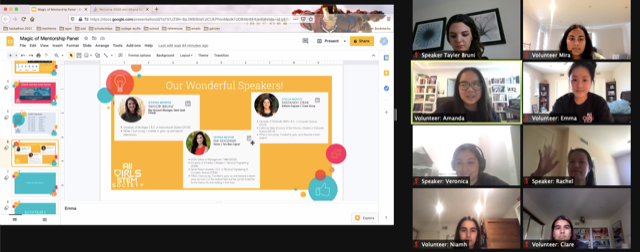|
On July 18th, All Girls STEM Society held their Geometry Workshop which was the second of a two part summer series on competition math. Even in the middle of summer, over two dozen dedicated girls participated. To accommodate different levels of prior exposure to material and different learning styles, the girls were split into breakout rooms. Emma took girls who had already learnt the material before to a separate breakout room. She noted that “After the first week, we realized that every participant had a different level of experience with competition math. Some had never seen it before, while some were already very skilled, which was totally okay! Everyone starts somewhere. So in order to make sure every girl learned something and challenged themselves, we decided to split off into breakout rooms so that we could better meet the needs of each participant.” Meanwhile, Amanda took most of the girls through angles and triangles. Amanda kicked off the workshop with an introduction to angles. She started simply by asking girls to define what angles were. Lucinda and Bridget provided two different, but correct descriptions. Amanda then walked girls through the different types of angles including acute, right and obtuse angles. To illustrate her point, she showed girls funny comics about right angles. After learning about complementary and supplementary angles, the girls worked together on their first problem. Kiana bravely volunteered to solve the first problem. Although she was initially tripped up by an angle that looked right but wasn’t, she was ultimately able to set up the correct solution. After many girls volunteered their definitions in the chat, Amanda moved on to parallel and perpendicular lines. The final topics covered before the girls tried their hand at more problems were opposite and corresponding angles. Amanda used these ideas to prove something that many of the girls already knew, but had never known why it was true: the fact that triangles always have 180 degrees. The girls then applied these concepts to an angle chasing problem. Starting from only a few known angles, the girls figured out all of the unknown angles in a diagram.
The next topic covered was triangles. Amanda introduced different kinds of triangles with more comics that taught girls about obtuse, equilateral and right triangles. After the girls shared what they thought made a triangle a triangle, Amanda defined the properties of triangles and introduced the Triangle Inequality Theorem. The girls explored what happens when the Triangle Inequality Theorem is not met — you no longer have a triangle! They then applied the theorem to solve two problems. Next, the girls learnt about perimeter, area, special kinds of triangles and the Pythagorean Theorem. When Amanda asked the participants if they had heard of the Pythagorean Theorem, many of the girls enthusiastically declared that they had. For those who hadn’t Amanda taught the girls how to use the Pythagorean Theorem to solve for missing lengths in a right triangle. Then, the girls practiced using the Pythagorean Theorem on three different triangles. Anaya and Lucinda both volunteered to share their solutions. Finally, the girls learnt about the area of a triangle and proved why it worked. After a short break during which the girls discussed the possibility of going back to school in the fall, the workshop resumed to cover similarity and congruent triangles. The girls particularly enjoyed pictures of turtles eating strawberries resized and rotated to illustrate similarity and congruence. They then learnt about conjectures that prove similarity or congruence such as the side-side-side conjecture or the side-angle-side conjecture. Using their newfound skills, they tested different triangles for congruence or similarity. When Amanda color-coded the legs of a triangle incorrectly, the girls were quick to help her put the diagram to rights. The final topic covered in the workshop was special triangles which have special side length ratios. The girls learnt how to use these triangles to make problem solving a little bit faster. Although the girls initially struggled to apply this concept, they eventually worked it out, just as the workshop was ending. Through the entire workshop, girls asked questions and interacted with volunteers in the chat. While Amanda showed solutions, the girls came up with alternate solutions and interpretations and shared them with each other in the chat. It was this kind of interaction that led participants like Luna to type “THANK YOU VERY MUCH FOR THIS AMAZING LECTURE !!!!!!!!!” in the chat.
0 Comments
Leave a Reply. |
Archives
June 2024
|
All Girls STEM Society is a 501(c)(3) nonprofit organization.


